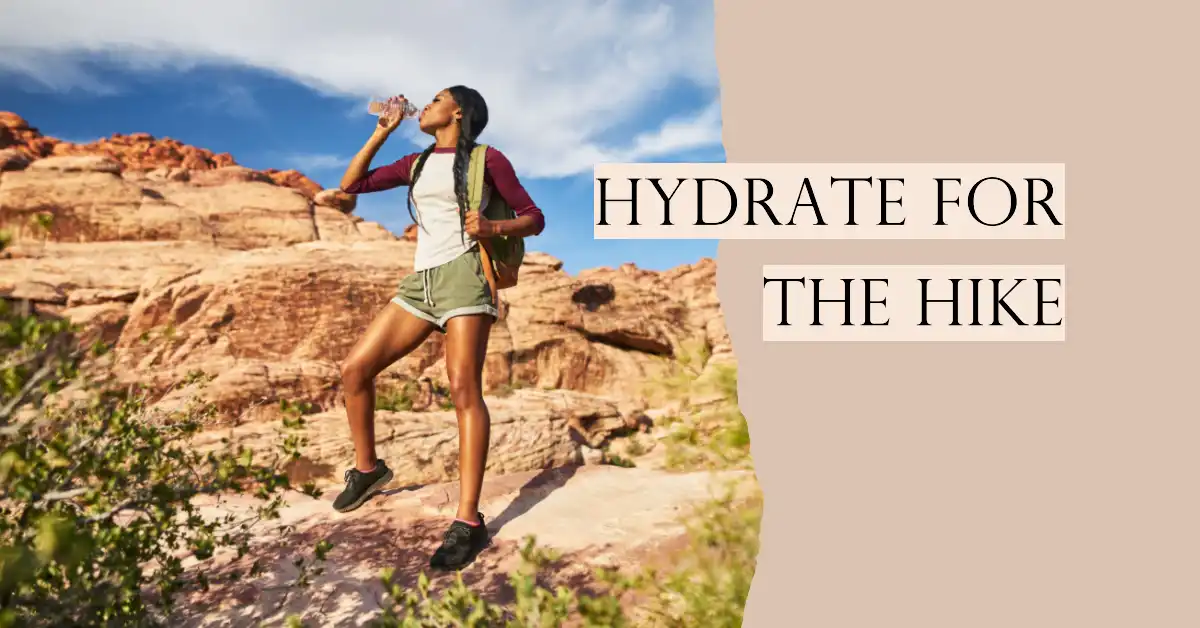Table of Contents
Some links on posts are affiliate links and will earn us a commission from qualifying purchases
Hiking is an activity enjoyed by millions of people around the world. It offers a chance to get outdoors, explore nature, and challenge oneself physically. However, hiking can also be very strenuous and tiring, especially when hiking for long distances or in hot weather.
One of the biggest challenges hikers face is staying hydrated throughout their journey. Water consumption while hiking is critical for maintaining good health and avoiding dehydration.
A lack of water can lead to serious consequences such as heat exhaustion, heat stroke, and even death in extreme cases. Many hikers underestimate the amount of water they need to drink while on a hike, which can lead to dehydration and potentially dangerous situations.
Understanding Water Needs During Hiking
Hiking is a physically demanding activity that requires a lot of energy and hydration to sustain performance. Therefore, understanding the water needs of the body while hiking is crucial for enjoying a safe and successful hike. The amount of water required during a hike depends on various factors such as temperature, altitude, and activity level.
Factors Affecting Water Needs
The body tends to lose more water during physical activities in hot environments due to sweating caused by the heat. Therefore, hikers should consume more water while hiking in hot weather than when hiking in mild conditions. Altitude also affects hydration needs since air pressure decreases with increased elevation leading to faster breathing and loss of moisture from the body.
Activity level is another factor that determines how much water the body requires during hiking. The harder and longer you exert yourself – especially when carrying weight – can quickly deplete your hydration levels, requiring more frequent consumption of fluids.
Recommended Daily Water Intake for Hikers
The amount of recommended daily water intake for hikers varies based on factors such as age, weight, gender, and health status. However, most health professionals recommend drinking at least 2 litres (68 ounces) per day under normal circumstances for an adult weighing around 150 pounds. For hikes lasting longer than two hours or taking place in high heat or altitude conditions it’s best to increase this amount significantly.
It’s important to note that these recommended amounts are just guidelines and may not apply universally across all hikers or situations – everyone has different individual requirements according to their unique physiology and environment they will be exploring. It’s therefore important that hikers monitor their personal water consumption while hiking.
Sources of Water During Hiking
Natural sources (streams, lakes, springs)
One of the most exciting aspects of hiking is the opportunity to explore and discover new natural environments. Luckily for hikers, streams, lakes, and springs are often present along hiking trails.
These natural sources can provide water that is not only refreshing but also potentially richer in minerals and nutrients than tap water. However, it’s important to keep in mind that natural sources may not always be safe to drink from due to the risk of contamination from animal waste or human activity.
Carrying water (hydration packs, bottles)
When hiking in areas without access to reliable natural water sources or where contamination risk is high, it’s essential to bring your own water supply. Carrying a hydration pack or bottle ensures you have enough water for the duration of your hike and can stay hydrated as needed. Hydration packs are especially useful because they allow hikers to carry a larger volume of water without adding weight on their hands.
Treating and filtering water
When drinking from natural sources such as streams or lakes on a hike, treating or filtering the water beforehand is an important safety measure. Water filters can remove harmful bacteria and parasites while chemical treatments like iodine tablets can also be used to purify questionable water.
Boiling the water for at least 1 minute can also kill bacteria present in untreated waters – both natural sources and tapwater- which makes it a good option when time permits. It is worth noting that no method of treatment will guarantee 100% safe drinking-water so precautions should still be taken.
Tips for Optimal Water Consumption While Hiking
Pre-hike Hydration
Before hitting the trail, it is important to make sure your body is well hydrated. This means drinking plenty of fluids in the hours leading up to your hike. It is recommended to drink at least 16-20 ounces of water two to three hours before beginning your hike.
This will give your body time to absorb and distribute the fluids throughout its tissues and organs. Avoid consuming alcohol or caffeine before a hike, as both are diuretics that can increase urination and lead to dehydration.
Drinking Regularly Throughout the Hike
One of the most important tips for optimal water consumption during hiking is to drink regularly throughout your trek. Waiting until you feel thirsty can be a mistake, as thirst is an unreliable indicator of hydration needs.
A good rule of thumb is to drink about half a litre (17 ounces) of water every hour during moderate activity—more if you’re sweating heavily or in hot temperatures. Be sure to take frequent breaks for sipping water and make sure that each member of the group has enough fluid during breaks.
Monitoring Urine Color and Frequency
Another effective way to monitor hydration levels during hiking is by observing urine color and frequency. Dark urine with a strong odor indicates dehydration, while light-colored urine indicates proper hydration levels.
Aim for clear to pale yellow urine when on a hike. If you notice dark-colored urine, be sure to increase fluid intake immediately and watch for other signs of dehydration such as headaches or feeling lightheaded.
Eating Hydrating Foods
Incorporating foods with high-water content into your diet can also help optimize hydration levels during hiking adventures. Fruits such as watermelon or cantaloupe contain high amounts of water along with essential nutrients and electrolytes. Foods such as cucumbers, lettuce, and celery also have high water content.
In addition to water-rich foods, consider packing electrolyte replacement drinks or powders to replenish lost electrolytes from sweating during the hike. These can be particularly important for longer hikes or more intense activities.
Dehydration and Its Effects on the Body
Dehydration is a serious condition where the body loses more fluid than it takes in. During hiking, dehydration can occur quickly especially if you are not drinking enough fluids to replace what your body loses through sweating and urination. Dehydration can lead to several health problems ranging from mild symptoms such as thirst, dry mouth, headaches, to more severe conditions such as heat exhaustion and heatstroke.
Symptoms of dehydration
As mentioned earlier, some of the mild symptoms of dehydration include thirst, dry mouth, fatigue, and headache. If ignored or left untreated, these symptoms can worsen leading to other signs of severe dehydration such as rapid heartbeat, shallow breathing, sunken eyes and cheeks. Severe dehydration may also cause dizziness or fainting spells which could be dangerous if you are on a steep trail.
Risks associated with dehydration during hiking
Dehydration poses several risks when you are out hiking in the wilderness. One of the most significant risks is loss of consciousness due to heat exhaustion caused by prolonged exposure to high temperatures without adequate water intake.
This can lead to falls or accidents that could potentially be life-threatening especially when hiking alone or in remote areas where help may not be readily available.
In addition to this, hikers who are dehydrated may also experience impaired judgement which could lead them into risky situations like attempting difficult trails without proper gear or pushing their physical limits beyond their abilities.
To avoid these risks associated with dehydration while hiking it is important to drink plenty of water throughout your hike and take regular breaks in shaded areas when possible.
Check out our comprehensive guide on dehydration
Keep an eye out for signs of mild dehydration so that you can address them before they become severe problems that require medical attention. By prioritizing proper hydration during your hikes you will not only protect yourself from potential dangers but also optimize your performance on the trail allowing you to enjoy your experience fully.
Conclusion
Throughout this article, we have examined the importance of proper hydration during hiking and explored various factors affecting water needs, sources of water on the trail, tips for optimal water consumption, and the dangers of dehydration.
It is crucial to remember that dehydration can affect anyone at any time and can have severe consequences. Therefore, it is essential to prioritize proper hydration during hiking.
Remember that each hiker’s needs are unique and may vary from one hike to another depending on several factors such as temperature, altitude, activity level, body mass index (BMI), and individual sweat rate. Ideally, you should aim for 0.5–1 litre of water per hour while hiking and consume additional fluids before or after the hike.
Therefore it is essential always to carry enough water or know where natural sources are located. Proper hydration can make all the difference when it comes to enjoying your outdoor adventure safely.
Remember always to drink regularly throughout your hike, eat hydrating foods like fruits high in water content like oranges or cucumbers. With these tips in mind remember always stay safe keep hydrated with plenty of water so you can enjoy all the great hikes out there without worry!
Recent Posts
Hiking is an excellent way to explore nature and challenge oneself physically. It’s an activity enjoyed by people of all ages and backgrounds. Hikers often venture into remote areas, such as...
I always advocate having water to hand when walking, and whilst I probably don't drink enough water day to day, if I am going on a long walk I will always have at least one bottle with me. I also...


